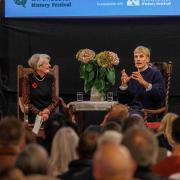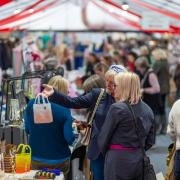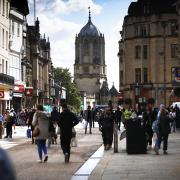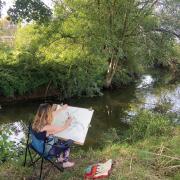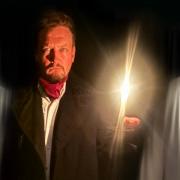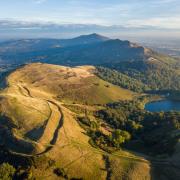The Stratford Greenway is a wildlife-friendly five-mile walking and cycling route that follows the course of an old single-track railway line – the Honeybourne Line – connecting Stratford-upon-Avon with Long Marston.
Stratford Greenway is known for its “corridor for wildlife”, and that’s evident in the variety of birdsong you’ll hear from its outset just a few minutes south of Stratford-upon-Avon town centre.
Redwings and song thrushes can be spotted at this time of year, while robins and swallows perched on trees or crossing from one tree-lined edge to the other give the opening leg an energetic feel.

Bipeds of all shapes and sizes, many with their young offspring, also flock to the five-mile route and compound the sense of constant motion. On a Sunday afternoon in February, they are out in full force after several rainy days in Warwickshire.
It’s a popular route, and an influx of cyclists and joggers add to the rush as they rip through puddles most walkers sidestep. Wellies may be desired for those who want to hurtle through at full tilt, but on a crisp, dry day the path is wide enough for pushchairs and wheelchairs to navigate with ease.
Stratford Racecourse flanks one side of the route’s opening phase, and at points you can see the jumps and grandstands. The heavy rain has left obstacles for us, too – but still, visitors of all configurations, from families of four atop new bikes to solo dog walkers who know the route well, ramble on.

There are a handful of manmade structures, such as the Stannals Bridge, which remind you this route is ultimately a practical one to connect Stratford-upon-Avon with Long Marston – but its closeness to rural Warwickshire gives the impression you are simply following your nose in the countryside with all its sounds, sights and smells.
In its current guise, the greenway dates back to the mid-19th century. It started life as a single-track railway – the Honeybourne Line – built in 1859 by the Oxford, Worcester and Wolverhampton Railway. The line closed in 1976, with the track now part of the vast Sustrans network which manages to accommodate skylarks, walnut trees, cowslips and wild carrot, as well as providing a peaceful link for cyclists travelling in and out of Shakespeare’s hometown.
The rural theme is constant throughout, but with ever-changing visuals – particularly in the first 2.5 miles. Crossing quick-moving rivers and streams, with a handful of farmhouses and small villages in the distance, you feel you are carving the ancient landscape in two via a royal highway or Roman road. In fact, some of the route overlaps with the Monarch’s Way, the vast 650-mile escape route taken by King Charles II after the Battle of Worcester in 1651, who allegedly passed some of this woodland as he fled to France following defeat to Oliver Cromwell.

Were he making the trip today, he probably would have sought refuge in at least one of the two carriage cafés serving as checkpoints along the greenway – providing they were sympathetic to his cause. Luckily, these tremendous independent cafés, to which the greenway must owe much of its modern popularity, will not examine your sovereign allegiance on entry. The former railway vestibules-turned eateries have been on the greenway for around two decades, and visitors will be pleased to know they plan to stick around after signing new lease agreements.
Bobby’s Café, located near the very start of the route overlooking the racecourse, offers artisan coffee and menus using local produce, and even doubles as a deli and wine bar with tasting events in addition to live music and film nights. It takes its name from the slang for a train signal operator, and its prime location just a few minutes away from the car park on Seven Meadows Road means people need no encouragement to make use of it.
The Milcote Café, run by a father and daughter duo, also draws a crowd. Found in the middle of the greenway, it offers the classics with a great selection of homemade cakes, plenty of outdoor seating and an incredibly friendly welcome.

Beyond the halfway point, the vistas are green and open. Eventually, the tree-lined path narrows to a vanishing point in the distance, with the sun hovering in its sights. In this light, the greenway is stunning – especially when views stretch out and you can see far into the country.
The motivation for creating and maintaining this now well-trodden route is to allow humanity and nature to coexist, and it would be easy to be absorbed by the impressive middle-distance, ignoring the plant life, rivers and birds waiting to be discovered in the foreground.
Many walkers appear to get to Milcote and turn back. It’s still a rewarding journey, especially for anyone travelling with children, those who want to explore central Stratford, or if you have an evening performance of A Midsummer Night’s Dream to catch at the RSC. This also means you can make a serious dent in your step count without jeopardising your caffeine levels.

For those who have the afternoon to explore, you could do worse than heading out towards Long Marston, not just for a more robust workout, but for the leafy solitude found in the second half of the greenway – which is also a permissive bridleway, allowing horses to pass through without navigating traffic.
If you want to complete the full route, one option to get back to the start is the 27 bus to Stratford – which takes around 40 minutes but only runs a few times a day, so plan ahead. There’s a decent pub, the Masons Arms, you can take refuge in – with a stop just outside.
For convenience, walking from Stratford to Milcote and back will still provide a couple of hours’ exercise – enough to burn some of the calories you take on board from the carriage cafés, and soak up as much of the wilder side of the county as possible. All while never being more than 30 minutes from a flat white.
countryparks.warwickshire.gov.uk













